What is the projection in drawing? Why does drawing require projection?
I’d start with introducing this game-changer in the art industry, a drawing projector. A drawing projector proves to be a very handy tool for artists of all skill levels. It can be used for various purposes depending on its type and the projection size they offer and is one of the most versatile devices on the market.
Photorealist painters traditionally used a projector to enlarge the image and then transfer it from their small photo onto a large canvas. This machine consists of a lens, a mirror, and a lightbulb. When a photo is placed into the projector, the image shines down onto the paper so the artist is able to draw the outline.
By adjusting the projector, either up or down, the image can be made at different sizes, allowing artists to control the size and composition of their final drawing.
On one hand, a drawing projector allows for more accuracy when transferring a digital image to a huge printed canvas or billboard and avoids incurring huge amounts of money by having it printed at a printing shop. On the other hand, you can transform digital art more with your self-painted or brushstroke touches.
Drawing projectors are similar to many home theatre digital projectors whether they’re handheld or particularly large, but they come with extra features specifically designed to help out artists in their artistic endeavors and challenges when push comes to shove.
Table of Contents
How is an Art Projector different from a Home Theatre Projector?
Art projectors are functionally similar to home theatres or even office presentation projectors with certain key differences that allow artists more leeway in order to use their projectors for image tracing purposes. For example, many of these offer custom grid layouts for better image proportions.
What’s the catch though? The catch is that they are expensive. There are drawing projector models that cost over a thousand dollars or so. Their whole purpose is to provide tracing abilities, high-resolution sharpness, and amazing clarity for art purposes.
What are the 4 Kinds of projectors for Art Use?
I’ll classify Drawing projectors into the following variants for your understanding:
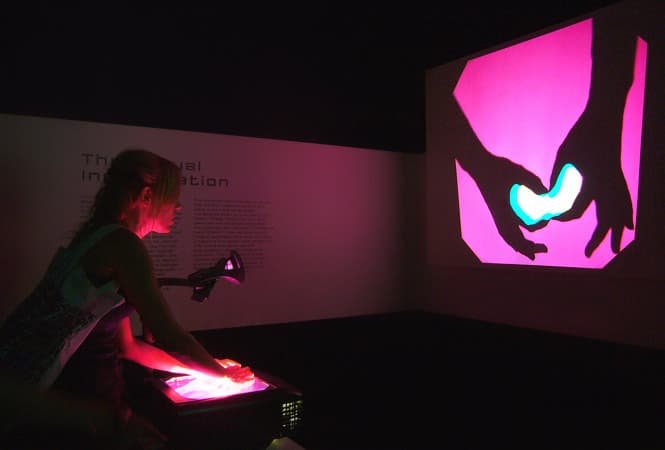
1. Digital projector: A digital projector is available to consumers as one, a home cinema projector (since it’s mostly used for viewing movies and TV shows). And two, as a business projector (since it’s also commonly used for projecting presentations for work or school purposes).
I found that many drawing projectors are of the digital variety since they’re widely available, come in portable and non-portable versions, and offer the sharpest, brightest, and most HD of images due to their tendency to be in 1080p FHD or 4K UHD.
2. Opaque projector: An opaque projector is one that projects the shadow of an opaque object you can fit onto it, like a hand or plant, so that you can trace the outline or silhouette of the said object onto the canvas or tarpaulin as required. It requires a dark room to function efficiently.
The main advantage of opaque projectors is the fact that they bring out the strongest and most realistic outlines of silhouettes compared to the flatter offerings seen in a digital projector. They consist of prisms or mirrors and enlarged reflections of sketches, images, and photos when I used them.
3. Slide projectors: A slide or slideshow projector somewhat works like a film projector. However, instead of creating the illusion of movement through the persistence of vision and sequential images moving at 24 frames per second, it showcases each slide image one after the other.
Slide projectors are definitely noteworthy as they showcase and present photographs in film. You can feature each photo one by one to those viewing it while you narrate the story behind it during the show. I used this technology to trace over photographs as well.
4. Overhead projectors: An overhead projector uses the same technology as that of a slide and opaque projector in order to showcase images. This time, instead of using opaque photographs or small transparent film slides, you’re using bond paper size (A4) plastic instead.
I could draw, paint, or paint images onto the A4 plastic sheet and then place them on the flatbed surface of the overhead projector. From here it is then projected to a much larger screen or wall through a series of mirrors. Thus its art tracing applications should be apparent.
What Should You Expect out of a Drawing Projector?
Digital projectors operate from images stored on your computer, laptop, smartphone, flash drive, or tablet. They can also project live images from your phone’s camera, play videos, and even project PDF, PowerPoint files, and Word docs. You can manipulate the image on the projector itself, for example, change it from color to black & white and back, or enhance its edges. Digital projectors are also bright and mostly work excellently in well-lit rooms.
A digital projector is more convenient and affordable for photorealist painters to use while enlarging and transferring photographs from their smartphone to their large canvas. Some critics call it tracing or cheating, but I stand by the notion that it’s a legitimate way to get the best bigger-than-life results in an artwork.
An ideal Drawing projector should be a handy tool for artists of all skill levels. Some projector options, mostly the non-digital ones, require a bit of scheming for them to work. For example, I needed a bond paper size transparent plastic sheet to print out and to make an overhead projector work.
It’s the same with slide projectors that require special film slides or opaque projectors which need a completely pitch-black darkroom to work.
However, you still have to know how to draw well using a drawing projector. Without some skill in drawing, your art will not be accurate or might fail to make sense. I’ve found that using the projector actually helps train your eye and makes your freehand drawing much better over time. Like anything else, it just takes practice.
Drawing Projector Buying Guide:-
What specifications should you search for when buying a drawing projector? Keep on reading to find out as I list out the features and comparisons between drawing projectors. However, I’d like to mention that you do not need the absolute best projector.
If you work in a small studio then you will be well served by a small projector. You only need a big, powerful and fancy projector if you work in an indoor-outdoor studio with a bright and challenging environment. I recommend a few projectors for use in display, photo enlargement, and art project creation.
1- Vankyo V600
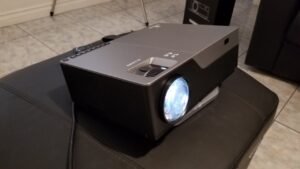
It is a budget Drawing Projector for artists. The features that I loved are:
- Its native Full HD resolution provided me with sharp image projections.
- Worked great in my outdoor spaces.
- I could control it with a remote.
- I was provided with a carrying case.
However, for an unbiased review, it is essential that I also list the factors that need improvement:
- Fan noise irritated me a bit when I used it for a longer duration.
- The speaker quality is very basic.
- Wireless connectivity isn’t available and that is something I feel could’ve been better if provided.
2- Epson 2150
This one is a medium-ranged projector that provides full HD resolution video. It is worth the money spent.

Features I loved are:
- It’s 1080 HD full resolution.
- Excellent color quality
- The images were sharp with no rainbow effect.
- I liked the build quality.
- Its wireless screen mirror is great.
However, Epson 2150 can work on these features:
- I wasn’t satisfied with the speaker quality
- High fan noise
- I felt the need for a carrying case.
3- Apeman Mini projector
If you are someone who has to travel and switch between the office and home for work, this ultra-small Apeman mini DLP projector will serve you well. I liked how it is very handy and portable.
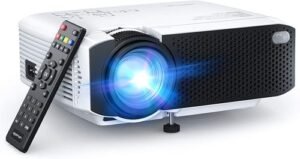
Pros of it are:
- Excellent picture quality with DLP technology.
- Battery backup is what I loved about this one.
- Build quality is sturdy.
- I can connect this to multiple ports.
- It has a 360° tripod.
The features that need improvement according to me are:
- The brightness seemed a little low to me.
- Speaker quality was below average.
- It lacks wireless connectivity and screen mirroring.
4- BenQ HT3550
Take murals to the next level with this 4K Drawing projector. BenQ HT3550 has a resolution of 3840 x 2160 pixels. This leads to an absolute HD view and it makes sure that you and I don’t see big pixels while working on canvases.
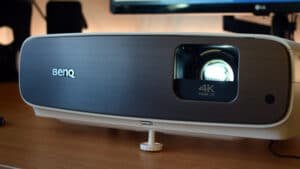
A few pros can be:
- The images were extremely detailed.
- It worked best when I used it indoors.
- Expensive but I found it to be worth the price.
- Focus and sharpness are great.
Certain cons for me would be:
- Lacks SD card slot.
- The speaker quality could’ve been better.
- I felt the need for wireless connectivity here as well.
5. Artograph prism art projector Multicolor – Best for Professional artists
This one is an opaque projector. It works by shining a bright streak of light on a printed image. It provides a maximum magnification of 20 times the size of the print. The size of the projected image increases as the distance between the projector and the screen increases.
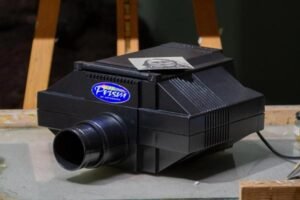
I’d give the following pros for it:
- It can project 3D images.
- 20x magnification.
- I found it easy to use.
- It’s a great choice for wall murals.
- It can also be used as an overhead projector.
Certain cons would be:
- Brightness seems low to me.
- I could only use it in a dim room.
- The big size made it tough to carry.
- A bit on the expensive side
Essential add-on with your Drawing Projector: A Tripod Stand
If you wanna avoid seeing the drawing projector permanently occupying a certain section of your art studio. Or if you want the freedom of being able to shift and move the projector without your ease, I’d highly recommend you get a projector stand. It is easily available on Amazon and other online shopping sites.
These stands consist of a flat top and a tripod stand which allows you to freely move the projector when not in use. The stand also gives you the option of elevating your projector at varying levels from the ground for the best possible results.
Conclusion
If you’re still unable to purchase a drawing projector, which I understand can be a bit of an expense; I suggest opting for manual methods. Other than projectors, you can transfer images using transfer paper or the grid method. Both are painstaking to do when compared to a projector. Projectors are no doubt an easier and hassle-free method for artists. However, if that seems like an unnecessary expense, quality work can still be done without a drawing projector.
You, as an artist, have to decide whether a method or tool is right for you. If you can’t get over the feeling that it’s cheating to copy and draw, then I wouldn’t recommend using the projector. Using the benefits of this technology or abstaining from it, it is totally up to you.
Artists reflect their personality and personal feelings through their work of art, so you must be honest with your methods, and do what feels right for you. For me, a drawing projector is my prized possession. It is one amazing invention that I believe more people should take advantage of.
Howdy Geeks, I'm Andrew, a young passionate blogger, Tech Freak & a Gadget Lover. I help people in buying them the best tablet devices

